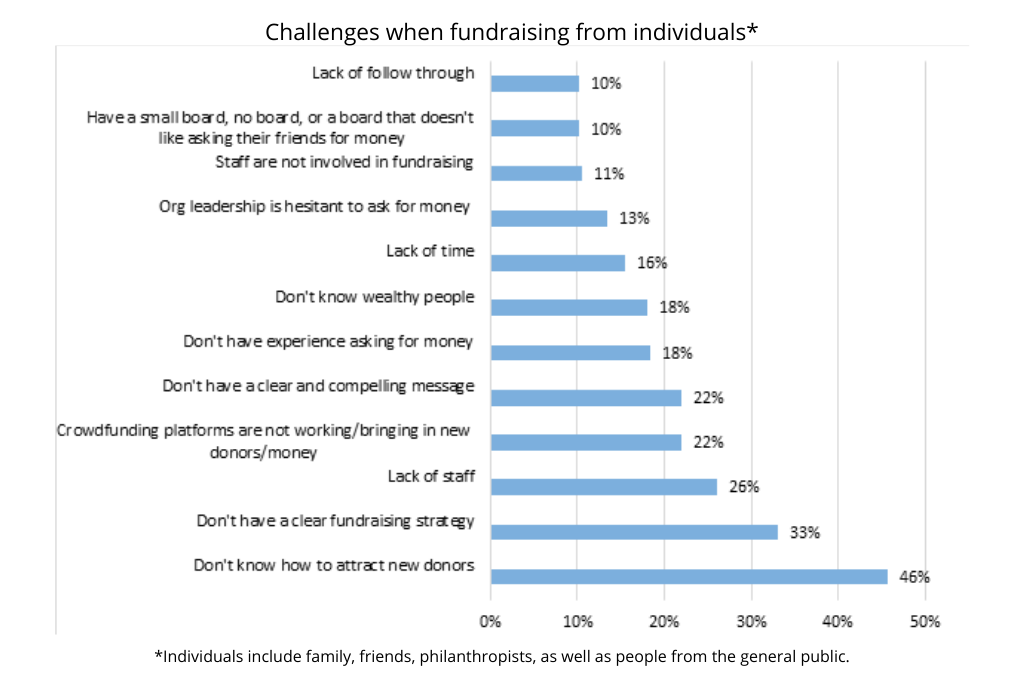Over the past several years, a series of reports have captured the state and potential of the individual giving market in India. These include Bain India’s Philanthropy Reports and the 2019 Sattva report on everyday giving in India, among others. Much has been written about how the market is growing, where the opportunities lie, and what needs to change. We wanted to add to this body of knowledge with a survey of nonprofits that lays out their fundraising approaches, challenges, and understanding of the market. So, in 2018, we conducted a research project in collaboration with Samhita and the Collective Good Foundation to understand what nonprofits are doing when it comes to fundraising, and what is working in the individual donor fundraising space in India. Nonprofits can use the ‘Indian Giving Benchmarking Report’ (part one of a two-part research project), as a practical tool to compare their fundraising against peers.
Methodology
We created a 40-question survey which we shared via e-mail with the 2,800 organisations in Samhita GoodCSR’s network in 2018. Of this list, 682 nonprofits filled out the survey, representing a 24 percent response rate. The scale of these organisations ranged from small (no paid staff and an annual budget of under INR 10 lakhs) to those with a staff of 5,000 and an annual budget that was more than INR 10 crore). Small nonprofits comprised 32 percent of the respondent pool, while the largest nonprofits comprised 6 percent. Forty-seven percent were medium-sized organisations (annual budgets between INR 10 lakh and INR 99.99 lakh) and 15 percent were ‘very large’ (annual budgets between INR 1 crore to INR 9.99 crore).
Here are some highlights from the study:

According to our survey, in FY18 the respondents reported the following:
- They raised an average of INR 49 lakh (approximately USD 68,000) from 191 individual givers.
- The median amount raised from individuals was INR 3.5 lakh (USD 4,860) from 30 donors.
They also reported having a diverse mix of revenue sources—with individual donors representing the largest share of total income at 35 percent.
- Thirty-five percent had their annual revenue come from individuals (friends, family, and general public), followed by government (18 percent), and CSR departments (13 percent).
- For small organisations, individual givers—philanthropists, friends, family, everyday givers—account for 60 percent of annual revenue; for large nonprofits, the figure is 16 percent, while for very large organisations, it’s 10 percent.
- When it comes to CSR, very large nonprofits received 35 percent of their income from companies, compared to seven percent for small organisations. As one survey respondent commented, “CSR doing companies are more focused today on funding big NGOs (may be authentic or not) rather than funding NGOs who need funds seriously to carry their objectives to a big level.”

Key insights from the survey
Fundraising strategies and approaches
Seventy-two percent of respondents said that they find new donors through their founder’s network, and that the most common methods for acquiring new donors include leveraging social media and board members. However, of the nonprofits surveyed, only 38 percent stated that their board members give money or are involved with fundraising. We found no difference by size of organisation (ie, there is the same level of involvement in fundraising for small, medium, large, or ‘very large’ nonprofits.)
Asking for money face-to-face also emerged as the most effective method for soliciting donations.
Asking for money face-to-face also emerged as the most effective method to solicit donations, with 68 percent of those who have adopted this method saying that it is an effective way to raise money. As one respondent shared, “Personal visits of the individuals makes the difference and they donate.”
Donor engagement
Annual reports and “beneficiary updates, letters, and interactions” top the list of activities to build relationships with donors (with 64 percent and 62 percent of respondents deploying these methods, respectively). Nonprofits said that they employ many other useful strategies as well, which help deepen their relationship with donors over time. These include texting donors (31 percent), impact reports (33 percent), social media (39 percent), and face-to-face meetings (32 percent).

Additionally, 54 percent of nonprofits had a volunteer programme to engage their potential and current donors. Volunteers help with organising events, providing advice, serving on governing boards or committees, and working directly with the beneficiaries.
Challenges when fundraising from individuals
The survey highlighted how almost half of all respondents (46 percent) don’t know how to attract new donors, and a third don’t have a clear fundraising strategy. This could be because of a lack of staff resources, which was pointed out as a common challenge (26 percent). And for smaller nonprofits in particular, no or limited access to wealthy people is a problem for fundraising large amounts.

What nonprofits need
When it comes to ‘retail’ fundraising (ie, fundraising from everyday givers as opposed to the ultra-wealthy), nonprofits require assistance with running effective crowdfunding campaigns, email appeals, sending direct mails, and so on. In the survey, they also expressed wanting training on how to make presentations to CSR teams, how to organise events and benefits, and how to get better at making face-to-face asks of funders. According to one survey respondent, “One of the key challenges [they] face is identifying and connecting with Indian philanthropists/HNIs.”
There is much work to be done by frontline fundraisers in terms of identifying donors as well as building, and nurturing relationships with them.
So, in this challenging time of lockdown and virtual schooling and work (for those of us who are lucky enough to work from home), it is more important than ever to keep our donors updated about what we are doing to advance our cause during the pandemic. Virtual visits between nonprofit CEOs and donors can keep the conversation going so that when the time comes to ask for a renewal gift, the request for support won’t seem unexpected.
There is much work to be done by frontline fundraisers in terms of identifying donors as well as building, and nurturing relationships with them. The results of our survey underscore the value of personal communication with donors (direct emails, telephone calls), the effectiveness of face-to-face encounters (via Zoom or WhatsApp), and finding meaningful ways to engage our donors in the mission of our organisation.
—
Know more
- Understanding how governments and philanthropy can create an environment to drive capital into the social sector.
Do more
- Build your individual fundraising skills by taking an online course (eg, Acumen Academy’s free six-week course for nonprofits starting on February 16, 2021 called ‘Nonprofit Fundraising Essentials: Embrace Entrepreneurial and Strategic Approaches to Fundraise More Effectively’)
- If you are a nonprofit operating in India, look out for the next individual giving benchmarking report in the summer of 2021.




